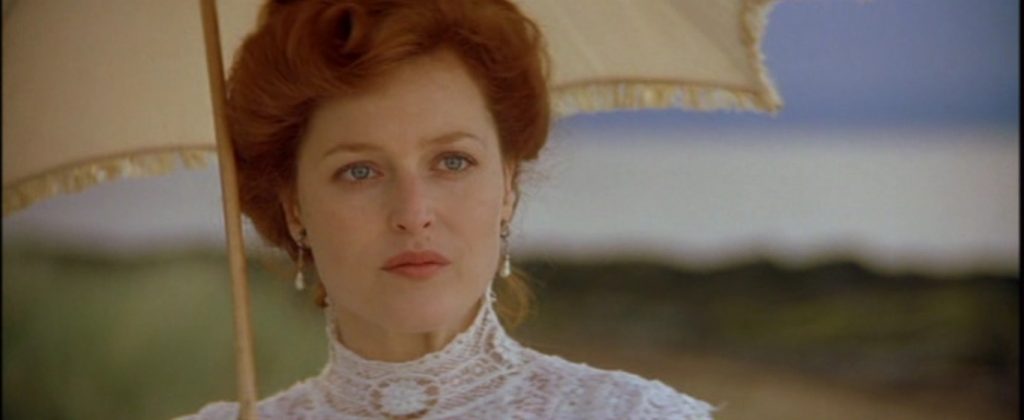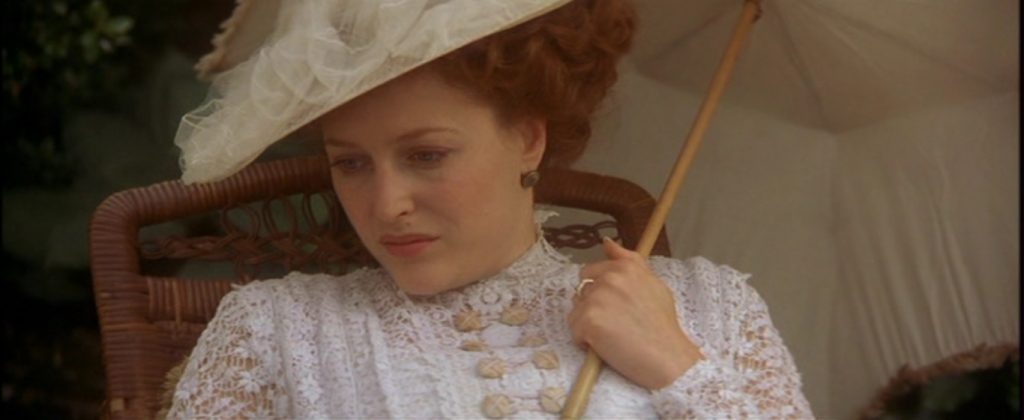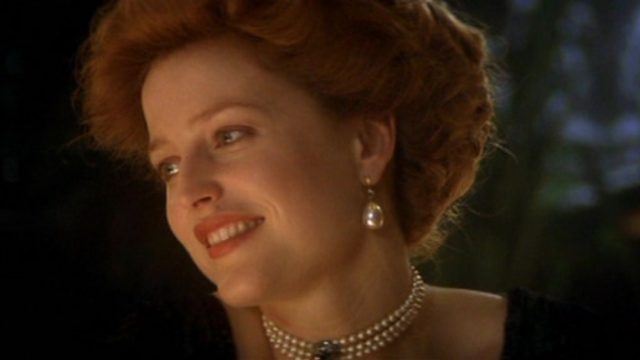When we first see Lily Bart, the doomed, honorable social butterfly at the heart of Edith Wharton’s The House of Mirth, as portrayed by Gillian Anderson in Terence Davies’ film adaptation, she emerges into darkness from the steam of a locomotive, a shape of a woman, her face invisible – a fragile and ghostly figure, but in the same spirit an immediately striking one. She is seen like this once more, near the film’s end, by which time she’s been more or less ruined by scandal and found herself near the bottom of the social ladder. What we see of her story begins about as close to the end as it can: she’s nearing 30 and is still unmarried – welcome to the smart set of 1900s New York – and it’s essentially a story of someone drowning, the outcome merely delayed by her occasionally coming up for air.
Dallying illicitly with non-wealthy lawyer Lawrence Selden (Eric Stoltz), entrusting her own money to her best friend’s husband, predatory stockbroker Gus Trenor (Dan Aykroyd), turning away from materialistic but ultimately sympathetic businessman Simon Rosedale (Anthony LaPaglia) and toward the self-centered, conniving Bertha Dorset (Laura Linney) and her ineffectual husband George (Terry Kinney), Lily is made of and surrounded by contradictions: at once naïve and cunning, fragile and stoic, appealing and threatening to those around her, smart but not pragmatic, too independent-minded and romantic for the Darwinian society she inhabits, yet not remotely fit to survive anywhere else. She may have fooled herself into thinking she doesn’t live in a snake pit, but the fact remains, even if not all snakes have bad intentions. As a key early exchange points out, she’s just not “nasty” – meaning, not prepared to hurt others to improve her station in life, even after they’ve hurt her. It’s one of the film’s crucial touches that, for all this, it doesn’t regard her as a saint, instead looking on, clear-eyed, with a mixture of exasperation and admiration.
Davies, one of the English-speaking world’s most singular major filmmakers, began his career with a series of arresting semi-autobiographical films – 1983’s The Terence Davies Trilogy, 1988’s Distant Voices, Still Lives, and 1992’s The Long Day Closes – that move increasingly freely through time and space, sounds and visions, as they attempt to find a unique way to communicate the flow of memory and the sometimes raw, sometimes melancholy tension between nostalgia and pain; the fate of all three was to be little-seen but much-beloved. Meanwhile, save for the documentary Of Time and the City, his 21st century output so far consists of four period pieces – three of them literary adaptations, one an Emily Dickinson biopic – each of which takes its own formal approach to a story of a socially isolated woman. The director himself has admitted that his 1995 adaptation of John Kennedy Toole’s The Neon Bible “didn’t work”; it’s a transitional work in an unfortunate sense, very obviously stuck between the two different modes, with the former imposing itself on the latter. But he also stated that he couldn’t have made The House of Mirth without it, and it’s clear that lessons were indeed learned: this is a work that exists in complete harmony with its source material, keeping Davies disciplined while necessitating new steps (it was his first, and arguably remains his only, film with a plot) and still allowing a personal rather than faceless approach.

The House of Mirth arrived fairly soon after that other great Wharton adaptation, Martin Scorsese’s The Age of Innocence, another story of social hypocrisies, cutting ironies and lost opportunities in old New York. It’s interesting to note that both these tales of turn-of-the-century high society were sensitively adapted by men raised as blue-collar Catholics; more interesting still is to observe their meaningful differences, born out of the breadth of their respective filmmakers’ resources as well as their temperaments. (Of course, in a business as practical as moviemaking, these aren’t entirely disconnected things.) Where Scorsese came to understand, and depict, this hermetic world through its excesses, Davies does the same through the stillnesses, the silences, the empty spaces, the loaded pauses between words spoken by all the same people constantly running into each other. He streamlines the novel’s story, getting through the introductions and table-setting quickly enough that virtually all developments have their foundation in the first twenty or so minutes, and utilizes quick dissolves as the means of transitioning between scenes, which creates an impression of actions – and, at one point, even whole stages of living – flowing and collapsing into each other, and heightens the sense of tragic inevitability. The grace notes in which time instead seems to slow down, such as the transition from the dusty rooms of New York to the sparkling waters of the Mediterranean or Lily’s final onscreen moment of happiness, right before someone’s casually uttered phrase will stab her, leave her for dead and get away with it in full view of witnesses, are all the more precious for being so rare.
The lighting and compositions are stark and simple, the music largely eschewed, though the film does make occasional – and always sublime – use of Marcello’s Oboe Concerto in D Minor, saving it for its most poignant moments. As in The Age of Innocence, there’s a scene at the opera, but where in that film it was used to introduce the audience to the onscreen world, here it’s one of the film’s most pointedly suffocating moments. As Lily endures unwanted attention from Trenor, her aunt (Eleanor Bron), sitting across the theater, learns for the first time both of his attention and of her gambling debts; the stage is set for the two terrible initial blows Lily will have to weather. Mozart plays all through the scene, but only serves to provide an aural trap in addition to all the physical ones. There’s no voiceover narration, thus one less outlet for Wharton’s wit, and no Gerty Farish, the novel’s most compassionate character; these eliminations emphasize the angry tragedy at the heart of the material.
Within this rigorously defined space, the performances are free to give the characters life, and track their respective journeys. The House of Mirth belongs in the hall of fame of unconventionally yet perfectly cast movies, and specifically literary adaptations; Gone Girl is the only other film on this level that springs to my mind, though there must be others. There’s the easy-going, sardonic Gen-X supporting player Stoltz as a romantic lead, a role in which he’s both so unexpected and yet so natural that it’s all too easy for both Lily and the audience to dismiss him or take him for granted until it’s too late. Aykroyd plays his role with a meatheaded aggressiveness that’s all the more chilling when stuffed and, for a time, well-concealed under the surface of propriety. And Linney, in perhaps the year that definitively announced her as a force to be reckoned with onscreen (just months earlier, she did phenomenal work in You Can Count on Me), is all dimpled smiles and pleasant manners – except the thing about Bertha is that she doesn’t mean any of it.

But it’s Anderson, in the one leading film role to really take advantage of her talents, who owns The House of Mirth, effortlessly embodying its multilayered protagonist. She has the charisma to show Lily as a skillful operator and professional coquette, who is, in Selden’s words, “always such a wonderful spectacle”; the strength to convey her reserved yet fierce pride after she’s wronged; the vanity-free readiness to finally expose, beneath the formerly self-assured façade, a trembling child (“I have tried hard! But life is difficult!” she cries in the climax, the unexpected and awkward plainness of the words amplifying the raw pain); and enough understanding to never condescend. She opens herself up to the genius of Lily’s characterization, which lies in the way all her many strengths and weaknesses fuel each other and cause her to do either the right thing at the wrong time or vice versa – and always in a way that feels not just understandable but unavoidable. It’s fitting that, in the end, she should arrive at the biggest seeming paradoxes of all: her purity destroys her, and her downfall elevates her above all.

